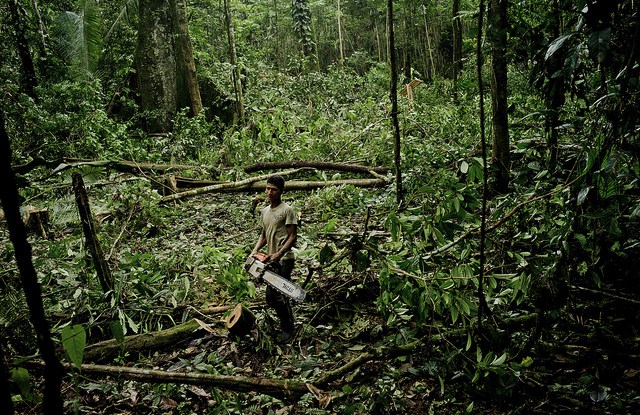
BOGOR, Indonesia—Logging roads can offer a simple, accurate way to estimate how much vegetation is removed by loggers, a study in Cameroon has found.
The method enables researchers “to see in an indirect way” the ecological effects of so-called selective logging, says Denis Sonwa, a senior scientist with the Center for International Forestry Research (CIFOR) and a co-author of the study. This type of logging tends to remove the largest trees and can lead to gaps in the canopy.
Sonwa said this method can provide useful data inexpensively, as the road network associated with logging can either be field-measured or captured by satellite images, which are already widely available to researchers. The fact that the satellite images can be used to give reliable proxies for estimating the trees that are harvested means that this data source is very valuable in supporting sustainable forest management planning, he said.
The region of Southeast Cameroon that was studied is set aside for sustainable logging, but researchers expressed concerns that two tree species—Triplochyton scleroxylon, known locally as “ayous,” and Entandrophragma cylindricum, known locally as “sapelli” —are more commonly removed by loggers. Policies should be devised, the researchers said, to ensure continued survival of these species and to ensure that other species were exploited more equally.
But scientists could argue their concerns about forestry policy more effectively if they had hard data on the loss of biomass and forest carbon stocks, derived from an estimate proven to be scientifically valid, Sonwa said.
That is something that logging roads and other parameters captured by satellite images could provide. Policy makers would then be able to negotiate from a position of strength with other government agencies and logging firms in the context of the REDD+ initiative, a program intended to reduce carbon emissions from forest destruction.
“This is one of the objectives,” Sonwa said. “It could help with the science. It will mean that when we sit down and talk to people who are carrying out the logging and people who are formulating policies and plans under which logging should take place, we are able to do so with scientifically verifiable data, which is harder to refute.”
The researchers also suggested that simply by placing logging yards closer to major roads, loggers could significantly reduce the amount of vegetation lost. Currently the yards tend to be farther inside logging concessions, necessitating more road construction.
EYE IN THE SKY, BOOTS ON THE GROUND
The study was conducted in 2013 in a concession in Southeast Cameroon targeted for selective logging. Rather than removing all trees, selective logging selects specific tree species with high commercial value.
However, these tend to be larger trees, leading to such ecosystem effects as gaps in the tree canopy that change microclimates; cause disturbances in the soil; and alter species composition, among other effects.
Applying statistical methods to ground-based observations, researchers found that the density of logging roads alone explains the biomass lost, as checked at ground level, to within 66 percent accuracy. When this result is combined with NDVI data collected from NASA’s Moderate Resolution Imaging Spectroradiometer (MODIS), , the accuracy of the estimate improved to 73 percent.
ROAD SIZE MATTERS
The system of logging roads was divided into primary, secondary, and tertiary roads, Sonwa said. The last category were the smallest roads, but because they were much more numerous overall, they affected a larger area of the forest, resulting in more forest biomass loss.
The study’s findings suggest that by simply creating log yards closer to the larger primary roads, loggers could significantly reduce the surface area affected by the tertiary roads and consequently the amount of vegetation that is lost, Sonwa said.
Forestry is economically very important to Cameroon. Loggers from around the world are exploiting its forests, including some from as far away as China and Malaysia. Sonwa said he had no illusions about their motives. “They are there to make money,” he said.
This information, he said, would at least help to put policymakers on firmer scientific ground in their efforts to design sustainable logging policies.
Importantly, this method could be replicated wherever selective logging is practices, Sonwa said.
For more information about the topics of this research, please contact Denis Sonwa at d.sonwa@cgiar.org.
This research was funded by the French Global Environment Facility (FFEM), The French Development Agency (AFD) and “Helsingin yliopiston alumni ry:n rahaston hoitokunta association” and forms part of the CGIAR Research Program on Forests, Trees and Agroforestry.
We want you to share Forests News content, which is licensed under Creative Commons Attribution-NonCommercial-ShareAlike 4.0 International (CC BY-NC-SA 4.0). This means you are free to redistribute our material for non-commercial purposes. All we ask is that you give Forests News appropriate credit and link to the original Forests News content, indicate if changes were made, and distribute your contributions under the same Creative Commons license. You must notify Forests News if you repost, reprint or reuse our materials by contacting forestsnews@cifor-icraf.org.

